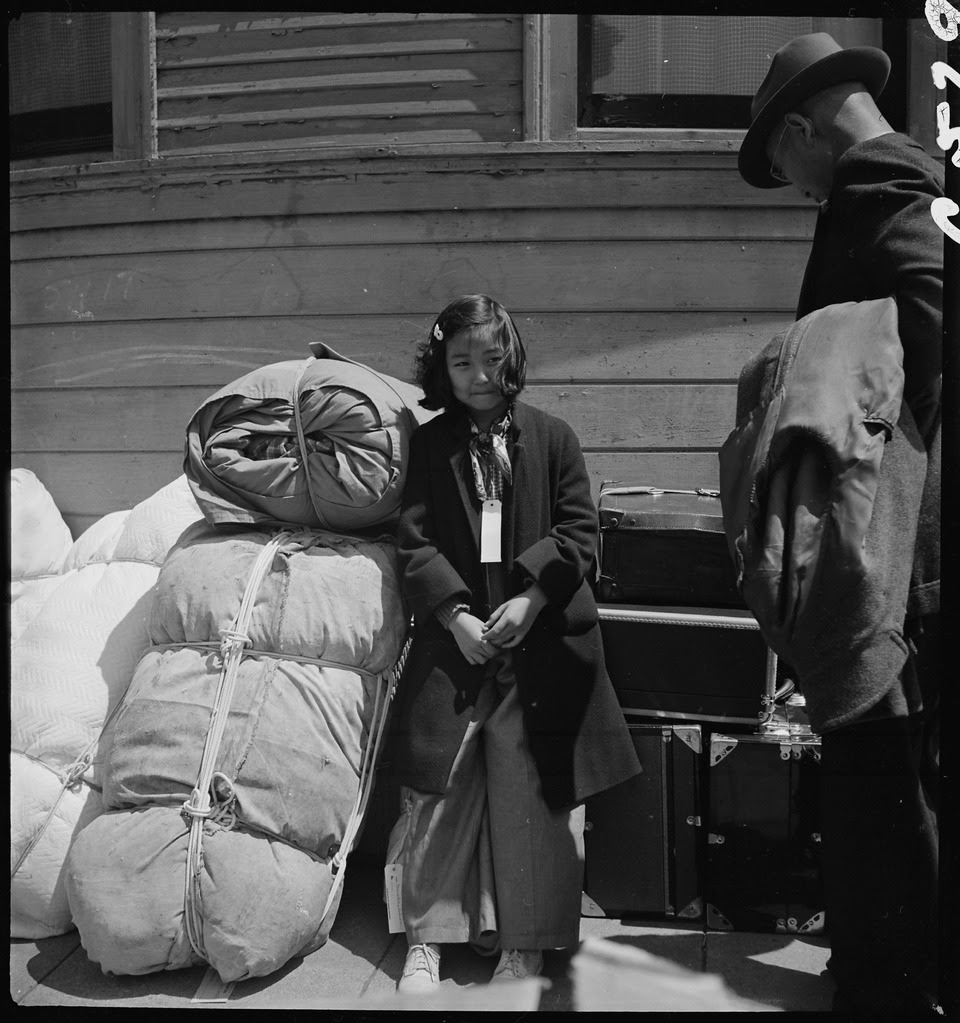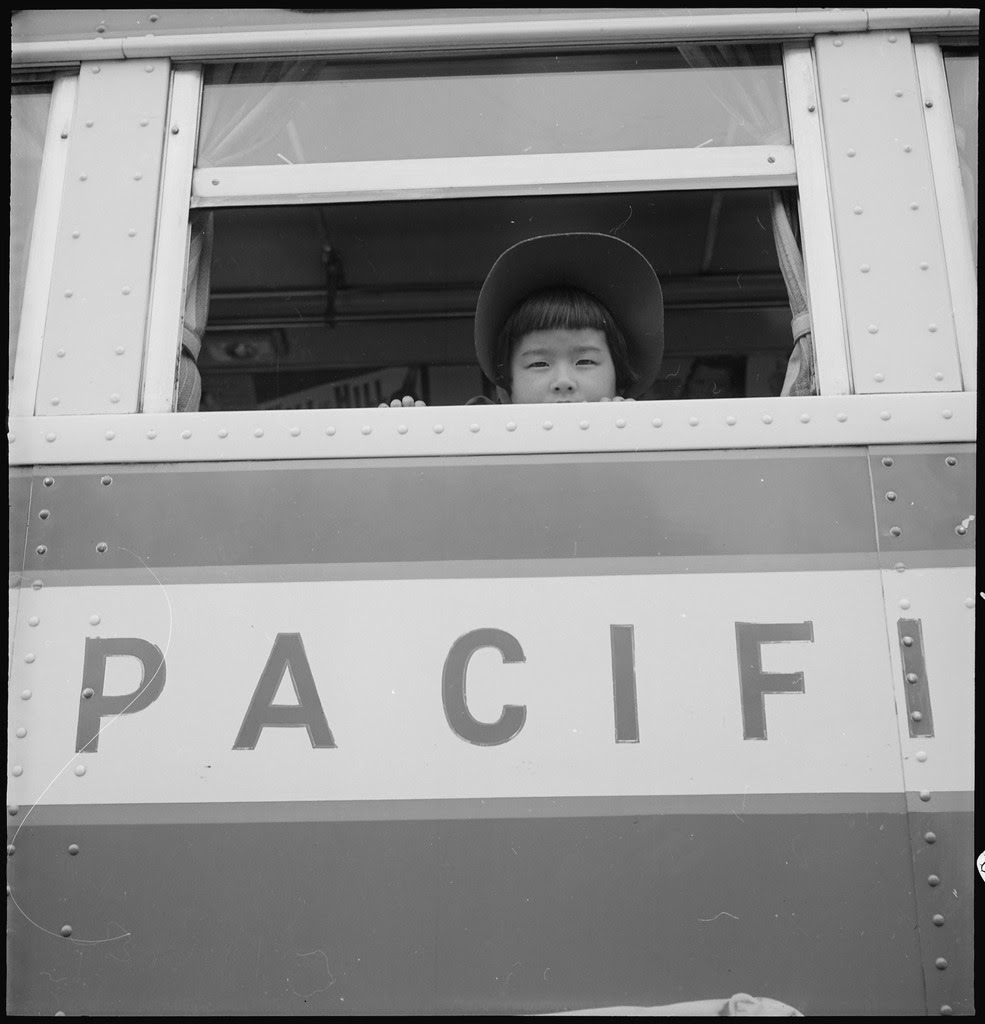Waiting for Registration, San Francisco, 1942: photo by Dorothea Lange (US National Archives)

Waiting for Evacuation, San Francisco, 1942. Members of the Mochida family awaiting evacuation bus. Identification
tags are used to aid in keeping the family unit intact during all phases
of evacuation. Mochida operated a nursery and five greenhouses on a
two-acre site in Eden Township. He raised snapdragons and sweet peas.: photo by Dorothea Lange (US National Archives)
Guarding the baggage, Oakland, 1942: photo by Dorothea Lange (US National Archives)
Waiting for the bus, Byron, 1942: photo by Dorothea Lange (US National Archives)
.
Waiting for the truck, Byron, 1942: photo by Dorothea Lange (US National Archives)
Pledge of Allgiance, San Francisco, 1942: photo by Dorothea Lange (US National Archives)
Mount Whitney, Manzanar, 1942: photo by Dorothea Lange (US National Archives)
Learning to walk, Manzanar, 1942: photo by Dorothea Lange (US National Archives)
Haircut, Manzanar, 1942: photo by Dorothea Lange (US National Archives)
Tending Guayule plants, Manzanar, 1942: photo by Dorothea Lange (US National Archives)
Camouflage nets, Manzanar, 1942: photo by Dorothea Lange (US National Archives)
Affairs settled, Woodland, 1942: photo by Dorothea Lange (US National Archives)

Oakland, California. A large sign reading "I am an American" placed in the window of a store, at 13th and Franklin streets, on December 8, the day after Pearl Harbor. The store was closed following orders to persons of Japanese descent to evacuate from certain West Coast areas. The owner, a University of California graduate, will be housed with hundreds of evacuees in War Relocation Authority centers for the duration of the war.: photo by Dorothea Lange for Department of the Interior/War Relocation Authority, March 1942 (National Archives and Records Administration)
"I Am An American" (East Bay Relocations)

Oakland, California. A large sign reading "I am an American" placed in the window of a store, at 13th and Franklin streets, on December 8, the day after Pearl Harbor. The store was closed following orders to persons of Japanese descent to evacuate from certain West Coast areas. The owner, a University of California graduate, will be housed with hundreds of evacuees in War Relocation Authority centers for the duration of the war.: photo by Dorothea Lange for Department of the Interior/War Relocation Authority, March 1942 (National Archives and Records Administration)

Berkeley, California. Residents of Japanese ancestry are closing out their businesses in preparation for the coming evacuation. They will be moved into War Relocation Authority centers to spend the duration.: photo by Dorothea Lange for Department of the Interior/War Relocation Authority, 19 March 1942 (National Archives and Records Administration)

San Leandro, Alameda County, California. Brand new church -- Pentecostal. Solomon 11:1 "I am the Rose of Sharon and the Lily of the Valley. As the lily among thorns, so is my love among the daughters.": photo by Dorothea Lange for Department of Agriculture/Bureau of Agricultural Economics/Division of Economic Information, April 1940 (National Archives and Records Administration)

Newstand, Oakland, California: photo by Dorothea Lange, February 1942 (Farm Security Administration/Office of War Information Collection, Library of Congress)

San Leandro, California. Watering young plants on a farm in Alameda County, California, prior to evacuation. Evacuees of Japanese ancestry will be housed in War Relocation Authority centers for the duration.: photo by Dorothea Lange for Department of the Interior/War Relocation Authority, 26 April 1942 (National Archives and Records Administration)

Oakland, California. Baggage of evacuees of Japanese ancestry piled on the sidewalk. The Greyhound buses will soon arrive to take this baggage as well as the evacuees to the Tanforan Assembly center under Civilian Exclusion Order Number 28.: photo by Dorothea Lange for Department of the Interior/War Relocation Authority, 6 May 1942 (National Archives and Records Administration)

Oakland, California. Young evacuee of Japanese ancestry guarding the family belongings near the Wartime Civil Control Administration station. In half an hour the evacuation bus will depart for Tanforan Assembly center.: photo by Dorothea Lange for Department of the Interior/War Relocation Authority, 6 May 1942 (National Archives and Records Administration)

Oakland, California. Members of the Japanese Independent Congregational Church attend Easter services prior to evacuation. Evacuees of Japanese ancestry will be housed in War Relocation centers for duration.: photo by Dorothea Lange for Department of the Interior/War Relocation Authority, 5 April 1942 (National Archives and Records Administration)

Hayward, California. A young evacuee looks out the window of the evacuation bus before it starts for Tanforan Assembly center. Evacuees will be housed in War Relocation Authority centers for the duration.: photo by Dorothea Lange for Department of Interior/War Relocation Authority, 8 May 1942 (National Archives and Records Administration)

Hayward, California. Farm families of Japanese ancestry are being checked into the evacuation buses which are enroute to the Assembly center. Their identification tags and numbers are inspected before entering the bus by a member of the Wartime Civil Control Administration Control Station staff. Over 400 persons were evacuated from this district on this date.: photo by Dorothea Lange for Department of Interior/War Relocation Authority, 8 May 1942 (National Archives and Records Administration)











Fourth photo. The hands.
ReplyDeleteThe hands, yes. The thumb at the crook; political force of such quiet intimacy at such moments.
ReplyDeleteAnyone who's tried to draw hands knows how much they communicate (and how bloody hard it is to do).
Thanks, Duncan.
ReplyDeleteYes, it's the firm steadying pressure of the mother's thumb upon her daughter's arm that seems to hold everything together, in this very precarious moment. The body language of the figural group, the subtle interactions, the direction of the glances of the concernful older brother and the vulnerable little sister, the tension of the situation contained in these movements and "attitudes" of bodies and hands and eyes, capturing the fear of the unknown, the apprehensive weight of what may come -- the picture tells us so much about humanity, about history.
One of the world's great photojournalists, at the peak of her powers, working close to home, bringing the skill of long practise to her work, and above all, approaching not only with field experience and political awareness but with compassion.
At this point DL had been taking pictures for the government for half a dozen years. Her concern for social justice shows in every shot. Very few of the thousands of pictures she made in this employment were published at the time. These particular shots were quietly deposited in the National Archives, virtually unseen till digitized in 2006, never publicized since. Lange was not an admirer of the evacuation and relocation programs. It's her documentation that allows us a glimpse of what such programs would look like.
ReplyDeleteAbout the compassion, some remarks of Lange's in a 1964 oral history interview about her work for her work in the 1930s for the Farm Security Administration gives a sense of the method that's also operating in the wartime internment photos.
RICHARD K. DOUD:...I've always found it rather strange that you could photograph individuals in some of the distressful conditions I know you found them in. Were you ever refused permission to photograph?
DOROTHEA LANGE: Oh yes. Oh yes.
RICHARD K. DOUD: You found certain areas of resentment toward --
DOROTHEA LANGE: Not areas, individuals. Naturally that couldn't be avoided, but you almost always sensed that, before it became explicit. I mean, you go into a room and you know where you're welcome; you know where you're unwelcome. You -- well, here I am talking about instincts again. But you find your way. Sometimes in a hostile situation you stick around, because hostility itself is important.
RICHARD K. DOUD: That's right.
DOROTHEA LANGE: The people who are garrulous and wear their heart on their sleeve and tell you everything, that's one kind of person, but the fellow who's hiding behind a tree, and hoping you don't see him, is the fellow that you'd better find our why. You know, so often it's just sticking around and being there, remaining there, not swooping in and swooping out in a cloud of dust; sitting down on the ground with people, letting the children look at your camera with their dirty, grimy little hands, and putting their fingers on the lens, and you let them, because you know that you will behave in a generous manner, you're very apt to receive it, you know? Those kinds of things. I don't mean to say I did that all the time, but I remember that I have done it, and I have asked for a drink of water and taken a long time to drink it, and I have told everything about myself long before I asked an question. "What are you doing here?" they'd say. "Why don't you go down and do this, that, and the other?" I've taken a long time, patiently, to explain, and as truthfully as I could.
RICHARD K. DOUD: And people generally would accept that you were trying somehow to help?
DOROTHEA LANGE: They know that you are telling the truth. Not that you could ever promise them anything, but at that time it very often meant a lot that the government in Washington was aware enough even to send you out. And there were times along then when the photographers were used in Congress, so that you could truthfully say that there were some channels whereby it could be told. Not about them, but about people like them. So it wasn't -- but you didn't have to do that all day long. People are very, very trusting; and also, most of us really like to get the full attention of the person who's photographing you. It's rare, you don't get it very often. Who pays attention to you, really, a hundred percent? Your doctor, your dentist, and your photographer. They really look at you, and it's nice, you know.